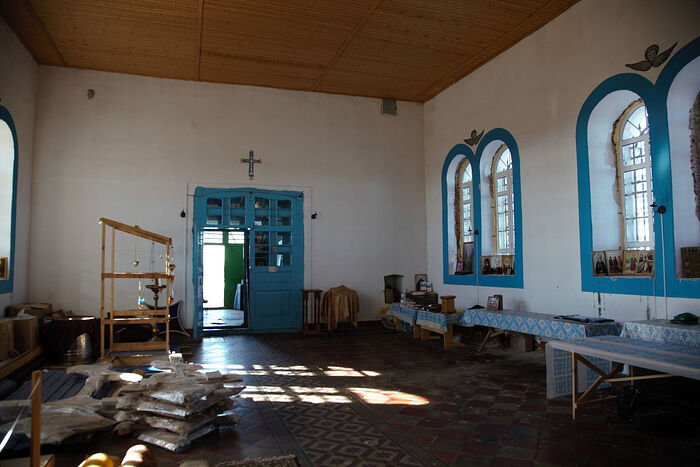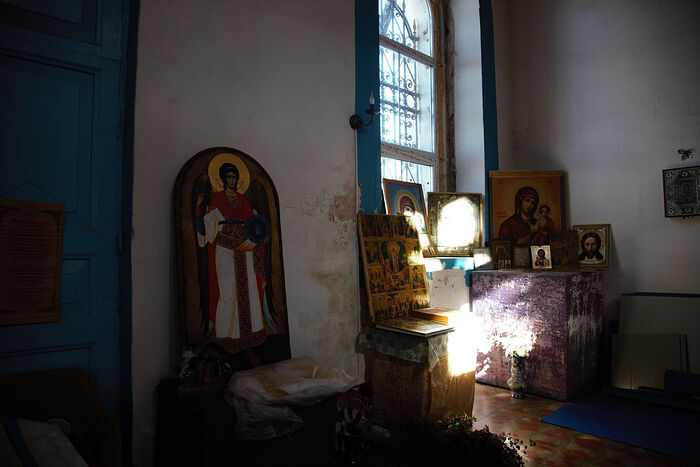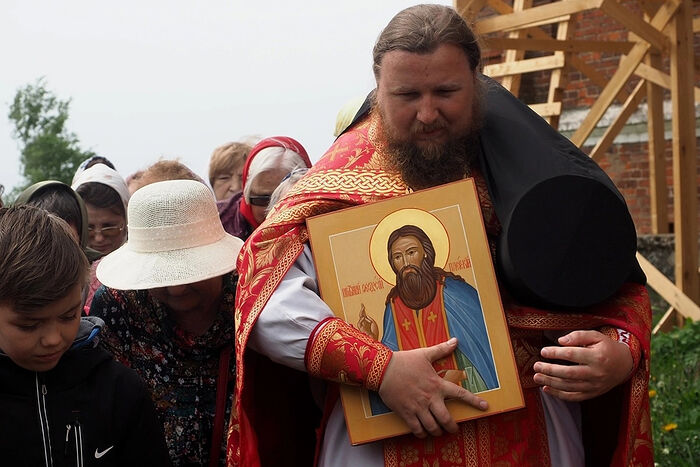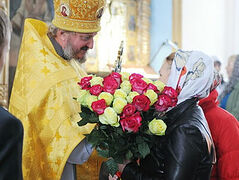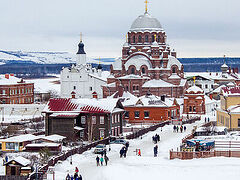Historians have the term “monastic colonization of Russia.” In the fourteenth century and later, ascetics traveled to settle in the deserted places such as forest for solitary prayer. Disciples would soon settle next to them and monasteries were founded there. The lay people drawn by the grace of the new monasteries would build their dwellings nearby to form so-called “posads” (or trading settlements) and towns, thus making the previously uninhabited places on the outskirts of Russia an organic part of the country. When those lands were historically inhabited by pagan tribes and peoples, they also, peacefully and non-violently, became accustomed to the culture of our Orthodox country. Therefore, Russia expanded not “by fire and the sword,” or in pursuit of gain, but because its people sought out God, purity and freedom of spirit. Our country has a new “desert” these days—empty places where villages and hamlets once stood a mere half a century ago. Some of them still have their churches. What if these churches could serve for the revival of the Russian countryside?
We are sitting on a bench in front of the Archangel Michael Church that crowns a small hill. Around us is a vast expanse of fields and forests, a practically pristine country road, and... a deserted land. It is hard to believe that some forty years ago this place was bustling with life. The village of Zarubinki was buzzing with activity and its church was full of people on major church feasts. I am talking with Hieromonk Theodosy, the rector of the church and the confessor of a tiny monastic community gathered around him.
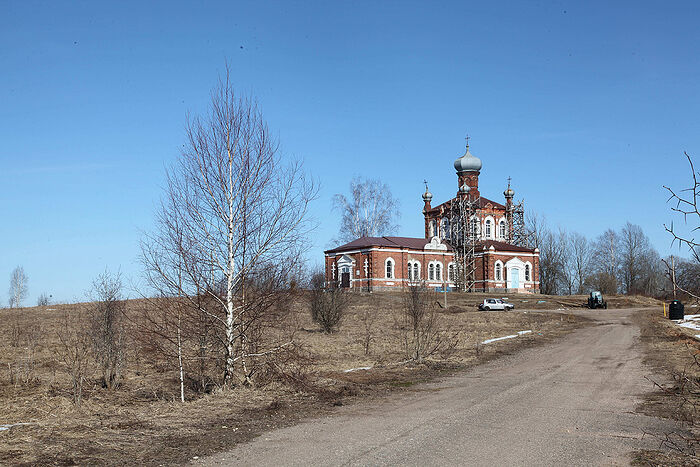 The Archangel Michael Church in Zarubinki
The Archangel Michael Church in Zarubinki
“A hundred years ago, this was the center of the village: a school, a post office, gardens, and houses,” batiushka says. “About a thousand five hundred people lived in Zarubinki. The Archangel Michael Church served several villages. It was open during nearly all the years of Soviet power; for some time, was one of only two functioning churches in the area between Smolensk and Vitebsk. Of course, people also suffered persecution here as well. Fr. John, the church builder and its first rector, was gunned down. In the late 1930s, the bells were taken down and moved to an unknown place, and the bell tower that could be seen as far as twenty kilometers away has been demolished. I met people who remembered it. They were over ninety years old when we began to restore the church. Another thing: it was forbidden to paint the interior church walls in light colors; it was imperative that lime was mixed with soot, so that the church was dark and gloomy inside. When I arrived, the walls were painted with black enamel and it took us a lot of effort to chip it off. As for the 1980s, the old residents recall that the collective farm didn’t forbid them to attend church; apparently, the leadership at that time was quite loyal and the church became the center of a vibrant and joyful life. We still have many visitors who say they were baptized or went to services as children here. But the last rector, Fr. Victor, passed away and they were not allowed to have a new one. The Archangel Michael parish was attached to the Kazan church in Kasplia and so it had only two services held in a year, on its patronal feast days.
—How did it happen that the church is being restored again?
—Apparently, by God’s Providence. It is not without reason that the Holy Righteous John of Kronstadt and the Tsar-Martyr Nicholas Alexandrovich took on the construction of this church. The locals needed it: when I first arrived here, the bench you and I are sitting on today was already here before us. It was here when the church was closed down, because there were people who came here to sit, pray, think, and simply admire these great spaces. And to find comfort and help from the Lord.
—How did you come to serve in Zarubinki?
—I served in Safonovo, also in the Smolensk region. It so happened that I had to transfer, but since there were no vacant parishes at that time, I decided to move to Belarus where I was born. I received the blessing of the hierarchs and even packed my belongings. And then... my documents got lost somewhere. I waited for two months, but I never arrived where I thought I would end up. I never even heard about Zarubinki at the time. But then suddenly our Metropolitan calls me and asks me to stay in the diocese, and offers to show me this church. Vladyka said: “Batiushka, go and see it, they really need a priest, the church is beautiful and large, but it stood closed for about thirty years...” And he promised that if I didn’t like it, he would give me another parish. A small group of devout parishioners, I’d say, a closely-knit group of friends in the faith and I got in the car and drove to Zarubinki. This took place on March 8, 2018; everything was still under thick carpet of snow. We came and saw this beauty. How could we not agree to take it? I didn’t even go to check out another church--the first choice is from God, the first blessing of my bishop.
—Were you scared?
—I had no doubts, such as, “It’s hard; how shall we survive?...” Except that we had to find an answer to a tough question: How are supposed to live? On the other hand, it was a bit scary, as we weren’t sure where to start.
It was about minus twenty Celsius inside the church. We wore felt boots, sheepskin coats, and my hands would freeze to the Chalice
During our first-ever visit here we couldn’t even get inside the church, we just walked around it, knee-deep in snow. On March 11, I received an official assignment to serve as its rector. We took rags, brooms, buckets and came here to clean up. People from the surrounding villages found out that a priest was finally assigned to serve in Zarubinki and came to help. They were very happy. So, the following Sunday we already served a Liturgy, despite the freezing temperatures of minus twenty Celsius inside the church. We wore valenki and sheepskin coats and my hands froze to the Chalice.... But no one got sick. We served this way throughout Lenten season that year—in an unheated, cold nave. We brought boiling water with us in thermoses. We served the Paschal service there, too: we heated the small aisle, separated from the central nave by a wall, heating with a wood-burning stove, so that all the children we brought wouldn’t freeze... Then, on Holy Trinity Ancestral Saturday, something remarkable happened; It was simply impossible not to restore this church after this. Many people came to the cemetery to commemorate their reposed loved ones. I served a Panikhida. An old lady stepped inside the church and began to cry bitterly. She came to me and knelt down in front of me. She said: “We truly thank God that our church is finally functioning! We couldn’t’ even dream that it would receive another chance to live!” From that time we began major repair work, and it has not stopped until this day.
—You must have accomplished much over the years?
—Thank God, yes! We made repairs in the side chapel of the “Hodegetria” Icon of the Mother of God, and started to hold services there. Next, we replaced several parts of our roofing system that badly needed repairs. The roof had huge holes right above the sanctuary and the centuries-old dirt kept falling from above onto the altars. It was scary as it could fall into the Chalice during liturgy. The altars were also in a pitiful state. We replaced rotten ceiling beams, the roofs over the altars, and purchased the church utensils we needed most. The ruling archpastor donated the Chalice and the Diskos to us—that’s when we remembered that, at the time of church founding, the local bishop had also donated the Chalice and the Diskos! Historical parallels! We also had donations of vestments, the epitaphion, and books. It was very hard at first, especially in winter. We served practically without any parishioners present. In fact, we were able to do all the repair work by ourselves: Fr. Vladimir, now a priest but at the time our parishioner, and myself. We didn’t hire anyone, as we simply had no money. During this process, we learned how to install rafters and the roof. We got rid of several tons of garbage from the attics where the birds had built their nests. We used buckets to take down droppings, sticks, and feathers... Thank God!
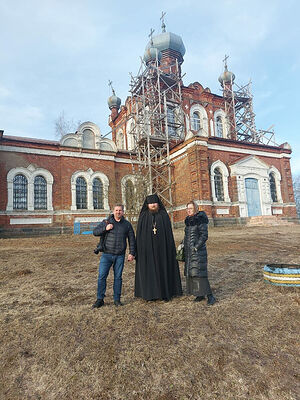 At the Archangel Michael Church. With Fr. Theodosy, the church rector, standing in the middle —How did it happen that a monastic community began to form at this church?
At the Archangel Michael Church. With Fr. Theodosy, the church rector, standing in the middle —How did it happen that a monastic community began to form at this church?
—I never dreamed there would be a monastery in Zarubinki. But over time, I understood that we should somehow make sure for it to become a community busy with people and an active parish life. We could restore the church and people would come here from Smolensk or the nearby villages—only to stand empty later. It is very difficult for a priest and a family to reside here: the nearest school is fifteen kilometers away and the village has no grocery store... Not every matushka would agree to come to live here. That’s why I suggested to the bishop to found a skete here and he gave his blessing. I already had helpers who wanted to become nuns: one was selling candles and another washed floors in the church. So, we had five sisters from the start and three more are waiting to enter our community. Last spring, we had our first tonsures: nun Michaela and three nuns—Martha, Nina and Thekla. The sisters carry out obediences in the kitchen, at church, in the cowshed and our dairy shop. I assist them whenever I am able. Everyone in the community has her obedience, but our main obedience is church service. Our typikon says that all the sisters must be present at services. Labor does matter, but prayer is no less important. A monk has two wings or two oars: prayer and labor. If one of them doesn’t work, we will be carried aside, unable to swim forward. That’s why we have time for labor, prayer and rest.
—Does farming help you to survive in this wilderness?
—Not just to survive, but also to earn a little to cover church repairs. The sisters and I have eight cows, chicken, piglets, bee farm, and a garden. We dug out a pond and put carp in it. We make our own cheese, dumplings, cottage cheesecakes, canned meat, and have sausages for sale—everything is natural and the people really like it. I am busy taking care of the farm and our animals, and I also mastered cheese-making process.
—How many people attend services in your church?
—In winter, we often pray alone--just the sisters and me. On summer Sundays, we have between twenty to twenty-five worshippers. We have two patronal feasts. On the day of the “Hodegetria” Icon of the Most Holy Mother of God on August 10, we have a gathering of two to three hundred people. It is a very ancient tradition to pay honors to this particular icon in Zarubinki. People arrive from Moscow, St. Petersburg, Belarus and, of course, Smolensk. On the day of Archangel Michael and on Pascha, we have around one hundred people.
 Fr. Deacon (now a priest) Vladimir Chepurov —What is your daily church schedule?
Fr. Deacon (now a priest) Vladimir Chepurov —What is your daily church schedule?
—In winter we have three or four Liturgy services per week, but in summer we hold services daily. Every day we have the morning prayer rule, Midnight Office, the Hours, Vespers, the Matins, and the monastic prayer rule. On weekdays, when there are no visitors, we start services differently: We can begin at either seven or eight o’clock—as soon as we finish taking care of our farm animals. We try to live according to the monastery typikon. Besides me, we now have two priests and a deacon. Fr. Vladimir, in addition to his ministry, takes care of our construction, while Fr. Vitaly and Fr. Deacon Alexander have secular jobs on weekdays. Fr. Vitaly teaches math and computer science, and Fr. Deacon is a doctor. On weekends, they conduct services, with Fr. Deacon serving in Zarubinki and Fr. Vitaly—at our small metochion, the chapel of the Great Martyr George the Victorious, in Rudnya. Fr. Vladimir, our second priest, has a wonderful wife. They have decided that her salary will be enough to live on, so he can serve the Lord by restoring the church and performing his ministry here. Of course, when there is such an opportunity, I try to help the fathers as much as possible—at least to cover the cost of gas.
To be continued…

